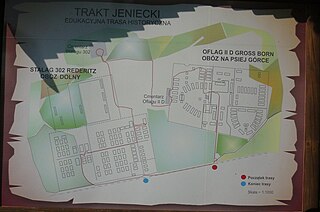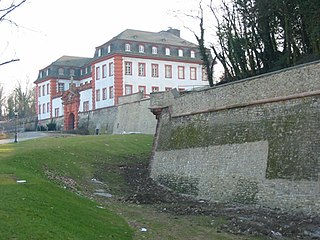
Oflag II-D Gross Born (Grossborn-Westfalenhof) was a World War II German prisoner-of-war camp located at Gross Born, Pomerania, near Westfalenhof (Kłomino). It housed Polish and French officers.

An Oflag was a type of prisoner of war camp for officers which the German Army established in World War I in accordance with the requirements of the 1899 Hague Convention, and in World War II in accordance with the requirements of the Geneva Convention (1929).
Oflag XII-A was a German-run prisoner of war camp for Allied officers during World War II. It was located at Hadamar, near Limburg an der Lahn in western Germany. It was created in November 1939 for Polish officers captured in the September campaign. In June 1942 it was renumbered Oflag XII-B.
Oflag VII-B was a World War II German prisoner-of-war camp for officers (Offizierlager), located in Eichstätt, Bavaria, about 100 km (62 mi) north of Munich.

Oflag VIII-F was a World War II German prisoner-of-war camp for officers (Offizierlager) located first in Wahlstatt, Germany and then at Mährisch-Trübau, Protectorate of Bohemia and Moravia.
Oflag X-B was a World War II German prisoner-of-war camp for officers (Offizierlager) located in Nienburg/Weser, Lower Saxony, in north-western Germany. Adjacent to it was the enlisted men's camp (Stammlager) Stalag X-C.

Camp Fünfeichen was a World War II German prisoner-of-war camp located in Fünfeichen, a former estate within the city limits of Neubrandenburg, Mecklenburg, northern Germany. Built as Stalag II-A Neubrandenburg in 1939, it was extended by the officer camp Oflag II-E in 1940. After the Soviet takeover in 1945 until 1949 it was used as special camp, NKVD-camp Nr. 9 of the Soviet secret service (NKVD). Today, the site of the camp is a memorial.

Oflag IV-C, often referred to by its location at Colditz Castle, overlooking Colditz, Saxony, was one of the most noted German Army prisoner-of-war camps for captured enemy officers during World War II; Oflag is a shortening of Offizierslager, meaning "officers' camp".

The Mainzer Zitadelle is situated at the fringe of Mainz Old Town, near Mainz Römisches Theater station. The fortress was constructed in 1660 and was an important part of the Fortress Mainz.
Oflag IV-D Elsterhorst was a World War II German Army Prisoner-of-war camp for Allied officers located near Hoyerswerda, then part of Lower Silesia, 44 km north-east of Dresden.

Oflag X-C was a German World War II prisoner-of-war camp for officers (Offizierlager) in Lübeck in northern Germany. The camp was located on the corner of Friedhofsallee and Vorwerkstrasse, close to Lübeck's border with the town of Schwartau, and is often cited as being located in Schwartau rather than Lübeck.

Oflag VII-C was a World War II German prisoner-of-war camp for officers located in Laufen Castle, in Laufen in south-eastern Bavaria from 1940 to 1942. Most of the prisoners were British officers captured during the Battle of France in 1940. To relieve overcrowding, some of the officers were transferred to Oflag VII-C/Z in Tittmoning Castle. The Oflag existed only for a short time. In early 1942 all the officers were transferred to Oflag VII-B in Eichstätt.
Oflag V-B was a World War II German prisoner-of-war camp for officers (Offizierlager), in operation from 1940 until 1942. It was located in Biberach in south-eastern Baden-Württemberg.
Stalag XIII-C was a German Army World War II prisoner-of-war camp (Stammlager) built on what had been the training camp at Hammelburg, Lower Franconia, Bavaria, Germany.

Oflag XXI-B and Stalag XXI-B were World War II German prisoner-of-war camps for officers and enlisted men, located at Szubin a few miles southwest of Bydgoszcz, Poland, which at that time was occupied by Nazi Germany.
Abraham Salomon Glück was a French physician and a member of the French Resistance.

Oflag X-D was a German World War II prisoner-of-war camp for officers (Offizierlager) located in Fischbek, a Stadtteil of Hamburg, Germany.
Oflag II-A was a German World War II prisoner-of-war camp located in the town of Prenzlau, Brandenburg, 93 kilometres (58 mi) north of Berlin. It housed mainly Polish and Belgian officers.
André Clayeux was a French athlete, soldier and sports director

Nazi Germany operated around 1,000 prisoner-of-war camps during World War II (1939-1945).













